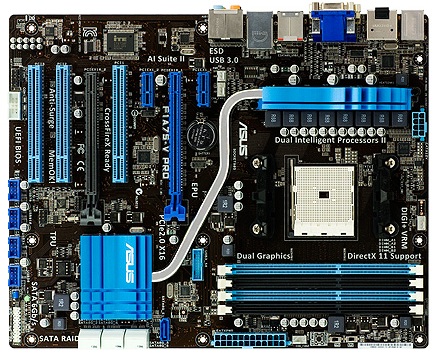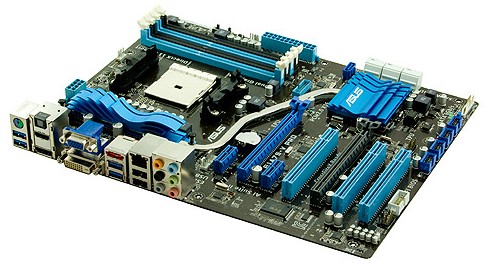ASUS F1A75-V Pro vs. Gigabyte GA-A75-UD4H – Llano at ~$120
by Ian Cutress on November 7, 2011 6:00 AM EST- Posted in
- Motherboards
- Gigabyte
- Asus
- A75
With recent reports showing a profit for AMD from Llano, we can safely say that the processors, and thus the chipsets, are selling. As a result, we have taken a full size A75 board each from ASUS and Gigabyte, in the $115-$120 range, and put them through their paces to see which one we would use. Results show that these boards are quite different in terms of performance and usability!
Overview of the ASUS F1A75-V Pro
Having had a play around with the ASUS board for a while, I can tell you it feels pretty solid as a platform for A75. There are a lot of features here, and the system provides the distinct ASUS stability and usability that we expect.
A few points are of note. The second PCIe x16 is actually runs at x4, limiting any dual GPU solutions that don’t use the APU, but on the plus side the board has all six SATA 6 Gbps ports from the FCH and another from an ASMedia controller—but this seventh would be covered by any long GPU in the first x16 slot. Also of interest is that this board does not have a Firewire port or header.
Software is good with the ASUS board, with options for the fan controls still being some of the best we have ever seen. Though as with the F1A75-I Deluxe I reviewed earlier there is a DPC Latency issue when the ASUS Suite II software is run. The BIOS still covers almost all the bases we want in a BIOS.
Visual Inspection
Out of the anti-static bag, this board feels refined. The stark black PCB with ASUS blues gives it a sturdy feel. Instantly noticeable is that the VRM heatsink and the FCH heatsink are connected by a thin heatpipe. Neither is substantial in size, however spreading the heat from heavy CPU or heavy I/O usage is always a good idea.

Around the socket itself are four fan headers, two above the first PCIe x1, one north of the CPU, and another tucked in beside the 24-pin ATX power connector. The four DDR3 DIMM slots have alternating latches, with the thicker ones indicating which banks to fill in first. To the right of the DIMMs we see ASUS’ dual intelligent processor switches, one controlling the EPU (energy saver) and the other being the TPU (turbo unit). These are now standard on a range of ASUS boards. Rather than a standard switch, personally I would prefer buttons with an LED to indicate if they are on or not. Next to these is a MEM OK button, which when pressed should default memory settings if they are incompatible or set too high.
Rather than split the 6 FCH SATA 6 Gbps ports between the board and eSATA as the Gigabyte board has done, ASUS have kept all 6 on board and added in an ASMedia SATA controller for a total of 7 ports on the board and one eSATA on the back. As one would expect, this extra controller does not get included in hardware RAID setups, but the six from the FCH support RAID 0, 1 and 10. However, the extra SATA port on board is blocked when a full-length GPU is used in the top PCIe x16 slot.
ASUS have stuck with ASMedia in their USB 3.0 controllers, with a header available between the DIMMs and the FCH. It seems in a slightly odd place, about an inch inside the edge of the board—usually they are placed on the bottom for a back panel connector or near the edge for a front panel connector. This is definitely in front panel territory, which is a shame that no USB 3.0 front panel device is included with the board, but given this is a ~$120 product, to ask for one would perhaps be asking too much.

Along the bottom are four USB 2.0 headers, as well as the front panel array, a COM header, S/PDIF out and front panel audio. Above these is the PCIe layout, which differs from the Gigabyte board. Here we have a PCIe x1, a PCIe x16 (which when populated with a full length GPU would cover the onboard ASMedia SATA port), another PCIe x1, a PCI, another PCIe x16 (electrically limited to x8, hardware limited to x4), and two more PCI slots.
The second PCIe x1 actually shares data lanes with the second PCIe x16, so when using two single lane GPUs for CrossFireX, this PCIe 1x becomes unavailable. However the first PCIe x1 can still be used.

The back panel is fairly standard with no surprises—a PS/2 connector; two USB 3.0 ports; an optical S/PDIF output; HDMI, DisplayPort, DVI-D and D-Sub video outputs; two USB 3.0 ports; an eSATA 6 Gbps; Gigabit Ethernet (Realtek 8111E); another two USB 2.0 ports and standard audio headers. I would have liked to see a Clear CMOS button, but with the IO this packed, I do not think there is space for it, unless they removed some features.










47 Comments
View All Comments
Mitch89 - Monday, November 7, 2011 - link
A proper sound card definitely sounds better than the integrated ones that come on every motherboard, no question about it.As for PCI slots, I still have a few devices in use in my machines including a few DVB-T digital tuners and a soundcard.
When building my latest Media Centre, however, I purchased a PCI-e DVB-T tuner, so the legacy slots we're something I was looking for.
knedle - Tuesday, November 8, 2011 - link
not really, the funny thing is that if you are interested in perfect sound, it's better to buy a board with integrated sound card and connect it with digital cable to amplifier, this way you are using amplifier as D/A Converter and you get way much better sound, than any sound card bellow $500 you can buycjs150 - Tuesday, November 8, 2011 - link
It is interesting to see what people use the old legacy PCI slots for. As mentioned in my first post I still use a TV card in one but to be honest there are better PCIex1 cards for that now (do not get me started on USB TV tuners - useless is the nicest description). I havent used a PCI sound card for at least 5 or 6 years. Last time I had an external card (bundled with an ASUS motherboard) it also used a PCIex1 slot.Now I am all for recycling old bits of kit to keep build costs down but there does come a point when it is time to wave good bye to legacy slots. Motherboards do not often come with a floppy drive port and IDE socket has basically gone the way of the dodo as well. PCI surely is the next to go. But maybe posters here have convinced me that there is at least a little bit of time left in it
DanNeely - Tuesday, November 8, 2011 - link
The only card I have that's legacy PCI is a BIOS POST code reader that I've been unable to find a PCIe1x replacement for; but with UEFI replacing BIOS it's about to become obsolete anyway.Googer - Sunday, November 13, 2011 - link
Sounds like you ought to keep an old legacy system for TV Tuners, SCSI, etc along side your new-fangled PC; both on the network so you can easily access the older equipment.Second, all of those devices listed are available in PCI-e, Quality Network Cards are available from Intel in PCI-e flavor. Creative makes X-Fi in PCI-e, and LSI (and adaptec?) Made a SCSI card in PCI-e. Serial Parallel ports can also be had with PCI-e and I agree that USB emulators for RS232/IEEE1284 are garbage.
Edgar_Wibeau - Monday, November 7, 2011 - link
From the screenshots I can see, the BIOS/UEFI version used with the Asus board is 0902. Yet, their current version is 1502, which dates 2011/10/21, and in between 1103 (2011/10/07) and 1102 (2011/08/26). Did you flash a more current UEFI after taking the shots? Or if not, why?See
http://www.asus.com/Motherboards/AMD_Socket_FM1/F1...
jan.peralta - Monday, November 7, 2011 - link
i would love to see gaming benchmarks for HD6670 with the A6, especially for the ASUS boardthanks!
Dug - Monday, November 7, 2011 - link
I second that!Dug - Monday, November 7, 2011 - link
I must be out of the loop.What does One 580 mean?
silverblue - Monday, November 7, 2011 - link
A single 580 as opposed to two of them.